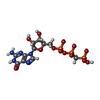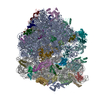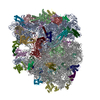+検索条件
-Structure paper
| タイトル | Structural analysis of noncanonical translation initiation complexes. |
|---|---|
| ジャーナル・号・ページ | J Biol Chem, Vol. 300, Issue 10, Page 107743, Year 2024 |
| 掲載日 | 2024年9月1日 |
 著者 著者 | Jacob M Mattingly / Ha An Nguyen / Bappaditya Roy / Kurt Fredrick / Christine M Dunham /  |
| PubMed 要旨 | Translation initiation is a highly regulated, multi-step process that is critical for efficient and accurate protein synthesis. In bacteria, initiation begins when mRNA, initiation factors, and a ...Translation initiation is a highly regulated, multi-step process that is critical for efficient and accurate protein synthesis. In bacteria, initiation begins when mRNA, initiation factors, and a dedicated initiator fMet-tRNA bind the small (30S) ribosomal subunit. Specific binding of fMet-tRNA in the peptidyl (P) site is mediated by the inspection of the fMet moiety by initiation factor IF2 and of three conserved G-C base pairs in the tRNA anticodon stem by the 30S head domain. Tandem A-minor interactions form between 16S ribosomal RNA nucleotides A1339 and G1338 and tRNA base pairs G30-C40 and G29-C41, respectively. Swapping the G30-C40 pair of tRNA with C-G (called tRNA M1) reduces discrimination against the noncanonical start codon CUG in vitro, suggesting crosstalk between the gripping of the anticodon stem and recognition of the start codon. Here, we solved electron cryomicroscopy structures of Escherichia coli 70S initiation complexes containing the fMet-tRNA M1 variant paired to the noncanonical CUG start codon, in the presence or absence of IF2 and the non-hydrolyzable GTP analog GDPCP, alongside structures of 70S initiation complexes containing this tRNA variant paired to the canonical bacterial start codons AUG, GUG, and UUG. We find that the M1 mutation weakens A-minor interactions between tRNA and 16S nucleotides A1339 and G1338, with IF2 strengthening the interaction of G1338 with the tRNA minor groove. These structures suggest how even slight changes to the recognition of the fMet-tRNA anticodon stem by the ribosome can impact the start codon selection. |
 リンク リンク |  J Biol Chem / J Biol Chem /  PubMed:39222680 / PubMed:39222680 /  PubMed Central PubMed Central |
| 手法 | EM (単粒子) |
| 解像度 | 2.59 - 2.75 Å |
| 構造データ | EMDB-43929, PDB-9ax7: EMDB-43930, PDB-9ax8: EMDB-45569, PDB-9cg5: EMDB-45572, PDB-9cg6: EMDB-45573, PDB-9cg7: |
| 化合物 |  ChemComp-ZN:  ChemComp-MG:  ChemComp-IAS:  ChemComp-GCP: |
| 由来 |
|
 キーワード キーワード | RIBOSOME / translation initiation / tRNA-fMet M1 / frameshifting / initiation factor 2 |
 ムービー
ムービー コントローラー
コントローラー 構造ビューア
構造ビューア 万見文献について
万見文献について














